Back spasms can be painful and debilitating. The back is a complex structure that needs to function properly in order for you to stand up straight.
When your back is in spasm you may find yourself bent over and unable to stand up straight without sending your back into more painful spasms. This is frustrating because how can you work, fulfill your parental duties, or even move from one room to the next if you’re bent over like a hockey stick.
This article includes information on how back spasms happen, as well as exercises and tips for standing up straight with back spasms.
What are Back Spasms?
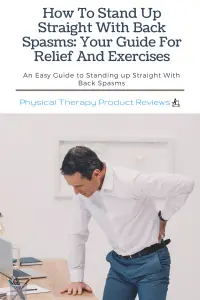 Back spasms happen when one of the back’s muscle groups is in a state of contraction. This happens because there was some sort of trigger to cause pain, like a fall or an injury, which then sends off signals along your back and causes its muscles to tighten up. In some cases, it can be hard for you to stand upright without back spasms.
Back spasms happen when one of the back’s muscle groups is in a state of contraction. This happens because there was some sort of trigger to cause pain, like a fall or an injury, which then sends off signals along your back and causes its muscles to tighten up. In some cases, it can be hard for you to stand upright without back spasms.
Back spasms can be short-lived lasting for only a few seconds or they can hang around for a frustrating few weeks. When they last for multiple days at a time it can be debilitating.
What Causes Back Spams?
There are a variety of back spasms triggers:
- Disc injury or history of disc injuries
- Facet irritation or history of facet joint injuries
- Injury/Fall on the hips or back
- Too much sitting or standing for long periods of time, especially if it is in one position
- Stress and anxiety
- Poor postural habits such as slouching in an uncomfortable chair or poor sleeping posture
- Overusing back muscles by lifting objects that are too heavy for you.
- Back muscle and core weakness with a sudden increase in activity levels
Why Can't You Stand Up Straight with Back Spasms?
When back spasms occur, it is difficult to stand up straight. You may be bent over from the back pain and find yourself unable to walk upright without sending your back into more painful spasms. This can lead you to feel frustrated as you are not able to work or move around freely because of back pain.
There are a few reasons why back spasms can cause you to have a difficult time standing upright.
If the spasms are caused by a new irritation to the lumbar intervertebral disc or especially the lumbar facet joints, standing upright causes more compression to the joint.

This increased pressure can cause the nerve to go into a “protect mode” and make the muscles spasm and tighten down. This prevents you from straightening up until the body has calmed down and isn’t trying to protect the joints in the back.
Pro Tip: Essentially, back spasms are a protective mechanism to prevent any further injury. You have to break through the protective mechanisms.
5 Helpful Exercises to Stand Up Straight During Back Spasms
While back spasms can be debilitating and cause you to walk awkwardly, it is possible to stand up straight. These exercises will help you learn how to do so while minimizing back pain:
Wall Back Extensions
You may have heard before that “the wall has your back.” This holds true for standing upright without back spasms as well.
To use a wall, back up to it and place your back against the surface of the wall while standing upright. Tighten your stomach and try to flatten the curve of your spine against the
Place one foot out in front of you, about two feet away from the other leg. This will help take some of the pressure off your back and allow you to relax for a moment before attempting to stand back up.
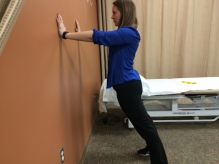
Prone Press Ups for Back Spasms
This is an excellent exercise to start getting your back to tolerate extension and a normal straight posture.
Start by laying on your stomach with a pillow underneath your hips. This pillow helps position the pelvis and low back in a position to take the pain levels down. Then using your arms push your chest up to the ceiling. Go as far as is comfortable and you may not get very high off the floor your first attempt.
Try to do it 10 times and perform a few different times throughout the day. The goal is to eventually get to full spinal extension.
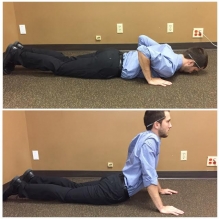
Swiss Ball Bird Dogs
This exercise starts by extending the back and core to help you stand up straight.
Start on all fours, with your back neutrally aligned. Tighten your stomach muscles and lift one arm straight out in front of you while simultaneously lifting the opposite leg off the ground behind you. This helps strengthen and stabilize the muscles that help the back get into an upright posture.
Do this for a few repetitions and continue to alternate each side.
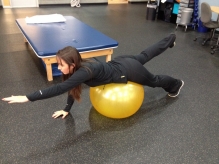
Elevated Glute Bridges
This exercise will help take the back pain away by strengthening the back muscles.
Lay on your back with a pillow or rolled-up towel under your head and neck to support them. Lift both legs and put them on an elevated surface such as the couch or a soft chair so that they are elevated off the floor. Tighten your stomach and lift your hips until they reach an upright position. This strengthens back muscles and can help with back pain in the lumbar region of the back by taking pressure off of it.
This also helps the facet joints tolerate coming into a closed pack position without the added pressure of gravity.

Swiss Ball Back Extensions
This exercise helps back spasms and pain by strengthening the back muscles.
Start on all fours with your back neutrally aligned with a Swiss ball under your stomach. Tighten your stomach again and then extend backward like you are flying like superman. Try and hold for 2-3 seconds and then relax again over the top of the swiss ball. Only go as high as you can before the pain starts and then relax. You should be able to eventually get to a fully straight position.
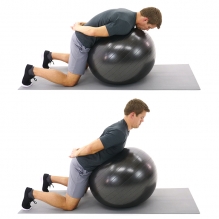
Helpful Tips for Standing Up Straight with Back Spasms
Even though it is painful to stand up straight after back spasms, it’s important to work towards getting back to a normal posture. Here are some helpful tips to speed up the process of getting you back to an upright position.
Use a Hot Pack to Relax Back Muscles
Applying a hot pack to back spasms can help relax the tight muscles. This will allow you to stand up straighter and decrease your back pain. Heat therapy also helps with pain relief and decreasing the pain levels in the area.
Use a Foam Roller or Massage Ball for Self-Myofascial Release
Having someone massage your back is great but it isn’t always an option. Using a back massager like a foam roller or massage ball can be used in place of someone else. These tools allow you to apply pressure that will release the muscle tightness and work with your body’s natural response to decrease the intensity and frequency of back spasms.
Incorporate Stretching into Your Daily Life
Stretching is one way to help mobilize muscles while also helping reduce back spasms. You may not be able to stretch as far as you normally do but even light stretching is a great option to reduce spasms. It is important that you stretch even if the back pain makes this more challenging.

Incorporating stretching into your daily routine will help bring some relief and decrease back muscle tightness which may be causing back spasms. One way to do this is to lie on the back and stretch your back muscles by bringing one knee to your chest and hold for 30 seconds. Repeat 3 times and try to perform multiple times throughout the day.
This may not be comfortable but it will help loosen back spasms, relax tight back muscles, and improve postural alignment which can decrease back pain.
Walk as Much as Your Body Will Let you
One great way to help stand up straight is to get the back moving and warmed up. Walking helps your back muscles stay strong while also allowing them the time they need for muscle recovery. Walking improves blood flow, loosens muscles, mobilizes the spinal segments, and keeps the muscles from losing strength.
If you can walk outside great but if not, they do make treadmills that are great for low back pain.
If You Can’t Walk- Try Other Forms of Exercise
Other forms of exercise can help you stand up easier as well. If you can’t walk, try swimming or riding a bike. These are light impact activities that help with spinal health and will help speed up healing in the back.
You may even be able to try an elliptical or, even better, a recumbent elliptical is a great option for anyone who can’t stand up straight due to back spasms.
In Review
Back spasms are common and can be challenging to stand up straight. The article offers different ways to help deal with back pain as well as reducing the frequency of back spasms. It is important for people with back problems to continue working on standing upright, even if it’s painful at first because this will decrease your chances of back problems in the future.
Other Great Exercise Related Articles
How to Stay Active After Cervical Fractures: Expert Tips and Advice
Dealing with Painful Stairs After Ankle Replacement Surgery
Walking After a Total Ankle Replacement: Tips for a Successful Recovery
Exercises While Non-Weight Bearing After Ankle Replacement: Elevation, AROM, Leg Raises, and More
Ankle Pain with Stairs: Causes and Home Treatment Options
5 Common Mistakes You’re Making After an Ankle Sprain
Disclaimer: The information provided in this post is for educational purposes only. This is not a substitute for a medical appointment. Please refer to your physician before starting any exercise program.








